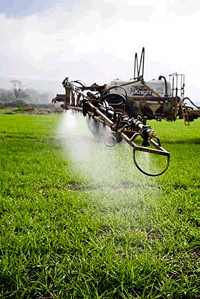Controlling rhynchosporium and fusarium in spring and winter barley

Rhynchosporium epidemics in spring and winter barley crops require different treatment approaches to ensure effective control.
The single peak epidemics typical in spring barley crops needed protectant fungicides applied before the disease was seen – typically from May onwards – while the multi-peak epidemics often found in winter barley crops required a season-long approach, said Simon Oxley of SAC, at a recent HGCA malting barley workshop.
“In winter barley, the disease is caused by seed infection and the weather. It is spread by rain splash, so crops could be carrying disease as they come out of the winter.
“Unfortunately, this means that you can be chasing the disease all season.”
T0 treatment at GS25-30, if disease is present, could give a 0.2t/ha yield response in winter barley, he said. “But the most responsive timing for control in the winter crop was the GS31-32 spray. At this stage, you should base treatments around prothioconazole plus a strobilurin.”
In spring barley, the T1 spray, made at GS25-30, was the best timing for rhynchosporium protection, continued Dr Oxley. “Again, base your spray on prothioconazole. With the right mixing partner, this timing also allowed you to protect against mildew.”
But the later T2 timing had given the best yield response in spring barley in the past few years, except where the variety was susceptible to mildew, he noted. “It’s the most effective timing to protect against ramularia, rusts and net blotch. And ramularia is a disease which is definitely on the increase.”
The new SDHI fungicides, which will be available in the next year or so, would have an important role to play in barley, predicted Dr Oxley.
“Their main strengths will be on ramularia, rusts and net blotch,” he said. “They have better protectant than eradicant activity, so they will need to be used in combination with the triazoles to get rid of disease.”
Although they gave good protection against rhynchosporium, they couldn’t be relied on in an eradicant situation, he added. “Prothioconazole still has the edge with rhynchosporium, but the new products do offer some activity on mildew.”
SAC work on forecasting ramularia leaf spot had shown a link between leaf wetness in April and May and eventual symptoms in a crop, he said. “It seems as though leaf wetness has an impact on spore production.”
Early fungicides, applied at GS25-30, could help to reduce late epidemics, he said.
Varietal resistance to ramularia did exist, although the ratings weren’t included in the HGCA Recommended List. “Tipple has good resistance to ramularia, but Quench is weak. Propino is another variety with a good rating.”
Mycotoxins
A new strain of Fusarium langsethiae is to blame for two mycotoxins which have been found in cereal crops since 2005, according to a researcher.
Speaking at the workshop, research projects manager Iain Slaiding of Campden BRI said the strain, responsible for mycotoxins T-2 and HT-2, was favoured by drier conditions than the fusarium strains which were responsible for producing the mycotoxin deoxynivalenol (DON). So they tended to occur at different times, he said.
“The EU is likely to set maximum limits for these two mycotoxins – they’re more hazardous than DON so we expect the limits to be as much as 10 times lower.”
Fortunately, UK malting barley had shown low levels in most seasons, which was not the case for the rest of Europe, added Dr Slaiding.
“However, they did seem to be a particular problem in oats, with high levels being detected from 2006 onwards.”
As the mycotoxins tended to be found in the oat husk, processing could remove them, he said. “But the figures are a cause for concern.”
